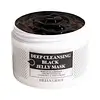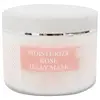What's inside
What's inside
 Key Ingredients
Key Ingredients

 Benefits
Benefits

 Concerns
Concerns

 Ingredients Side-by-side
Ingredients Side-by-side

Aloe Barbadensis Leaf Juice
Skin ConditioningHamamelis Virginiana Extract
AntiseborrhoeicCucumis Sativus Fruit Extract
EmollientChamomilla Recutita Flower Extract
MaskingCalendula Officinalis Flower Extract
MaskingChondrus Crispus Extract
Skin ConditioningGlycolic Acid
BufferingLactic Acid
BufferingActivated Clay
AbsorbentCharcoal
AbrasiveWater
Skin ConditioningPropylene Glycol
HumectantAcrylates/C10-30 Alkyl Acrylate Crosspolymer
Emulsion StabilisingTriethanolamine
BufferingParfum
MaskingMethylisothiazolinone
PreservativeAloe Barbadensis Leaf Juice, Hamamelis Virginiana Extract, Cucumis Sativus Fruit Extract, Chamomilla Recutita Flower Extract, Calendula Officinalis Flower Extract, Chondrus Crispus Extract, Glycolic Acid, Lactic Acid, Activated Clay, Charcoal, Water, Propylene Glycol, Acrylates/C10-30 Alkyl Acrylate Crosspolymer, Triethanolamine, Parfum, Methylisothiazolinone
Water
Skin ConditioningCarbomer
Emulsion StabilisingPropanediol
SolventAcrylates/C10-30 Alkyl Acrylate Crosspolymer
Emulsion StabilisingHydrolyzed Adansonia Digitata Extract
EmollientHoney Extract
HumectantHyaluronic Acid
HumectantTriethanolamine
BufferingChlorphenesin
AntimicrobialPPG-1-PEG-9 Lauryl Glycol Ether
EmulsifyingPEG-40 Hydrogenated Castor Oil
EmulsifyingCoceth-7
EmulsifyingRosa Gallica Flower Powder
Skin ConditioningParfum
MaskingAscorbic Acid
AntioxidantAloe Barbadensis Leaf Extract
EmollientRuscus Aculeatus Root Extract
AstringentHydrolyzed Yeast Protein
Skin ConditioningChondrus Crispus Extract
Skin ConditioningButylene Glycol
HumectantAmmonium Glycyrrhizate
MaskingPanthenol
Skin ConditioningEscin
TonicCentella Asiatica Extract
CleansingCalendula Officinalis Flower Extract
MaskingSodium Hyaluronate
HumectantWater, Carbomer, Propanediol, Acrylates/C10-30 Alkyl Acrylate Crosspolymer, Hydrolyzed Adansonia Digitata Extract, Honey Extract, Hyaluronic Acid, Triethanolamine, Chlorphenesin, PPG-1-PEG-9 Lauryl Glycol Ether, PEG-40 Hydrogenated Castor Oil, Coceth-7, Rosa Gallica Flower Powder, Parfum, Ascorbic Acid, Aloe Barbadensis Leaf Extract, Ruscus Aculeatus Root Extract, Hydrolyzed Yeast Protein, Chondrus Crispus Extract, Butylene Glycol, Ammonium Glycyrrhizate, Panthenol, Escin, Centella Asiatica Extract, Calendula Officinalis Flower Extract, Sodium Hyaluronate
Ingredients Explained
These ingredients are found in both products.
Ingredients higher up in an ingredient list are typically present in a larger amount.
Acrylates/C10-30 Alkyl Acrylate Crosspolymer is a synthetic polymer. It is used to thicken and improve the texture of products. Due to its properties, it can prevent water and oil ingredients from separating.
Calendula Officinalis Flower Extract comes from the common Marigold plant. This ingredient is a skin conditioner.
Marigolds contain flavonoids. Flavonoids are a group of substances found naturally in plants. They possess antioxidant and inflammation properties.
This ingredient soothes skin inflammation by inhibiting inhibiting a part of the inflammation process.
Marigolds have been used in traditional medicine throughout Asia and Europe.
Learn more about Calendula Officinalis Flower ExtractChondrus Crispus Extract comes from a red algae native to the northern Atlantic coasts of Europe and North America. It helps hydrate the skin and is rich in antioxidants.
The antioxidants in chondrus crispus include lutein and zeaxanthin. Lutein has the ability to filter blue light from screens.
Other contents of chondrus crispus include polysaccharides, peptides, and amino acids. These help hydrate the skin.
What's the difference between algae and seaweed?
Algae is a broad term that includes seaweed. Not all algae is seaweed.
Parfum is a catch-all term for an ingredient or more that is used to give a scent to products.
Also called "fragrance", this ingredient can be a blend of hundreds of chemicals or plant oils. This means every product with "fragrance" or "parfum" in the ingredients list is a different mixture.
For instance, Habanolide is a proprietary trade name for a specific aroma chemical. When used as a fragrance ingredient in cosmetics, most aroma chemicals fall under the broad labeling category of “FRAGRANCE” or “PARFUM” according to EU and US regulations.
The term 'parfum' or 'fragrance' is not regulated in many countries. In many cases, it is up to the brand to define this term.
For instance, many brands choose to label themselves as "fragrance-free" because they are not using synthetic fragrances. However, their products may still contain ingredients such as essential oils that are considered a fragrance by INCI standards.
One example is Calendula flower extract. Calendula is an essential oil that still imparts a scent or 'fragrance'.
Depending on the blend, the ingredients in the mixture can cause allergies and sensitivities on the skin. Some ingredients that are known EU allergens include linalool and citronellol.
Parfum can also be used to mask or cover an unpleasant scent.
The bottom line is: not all fragrances/parfum/ingredients are created equally. If you are worried about fragrances, we recommend taking a closer look at an ingredient. And of course, we always recommend speaking with a professional.
Learn more about ParfumTriethanolamine is an emulsifier and pH adjuster. It is created using ethylene oxide and ammonia. This gives Triethanolamine a nitrogen core and a similar scent to ammonia.
As an emulsifier, it prevents ingredients from separating and enhances texture by adding volume to a product.
PH adjusters are common in cosmetic products. The pH of a product can affect the effectiveness of other ingredients. A product with a high pH may also irritate the skin.
Learn more about TriethanolamineWater. It's the most common cosmetic ingredient of all. You'll usually see it at the top of ingredient lists, meaning that it makes up the largest part of the product.
So why is it so popular? Water most often acts as a solvent - this means that it helps dissolve other ingredients into the formulation.
You'll also recognize water as that liquid we all need to stay alive. If you see this, drink a glass of water. Stay hydrated!
Learn more about Water